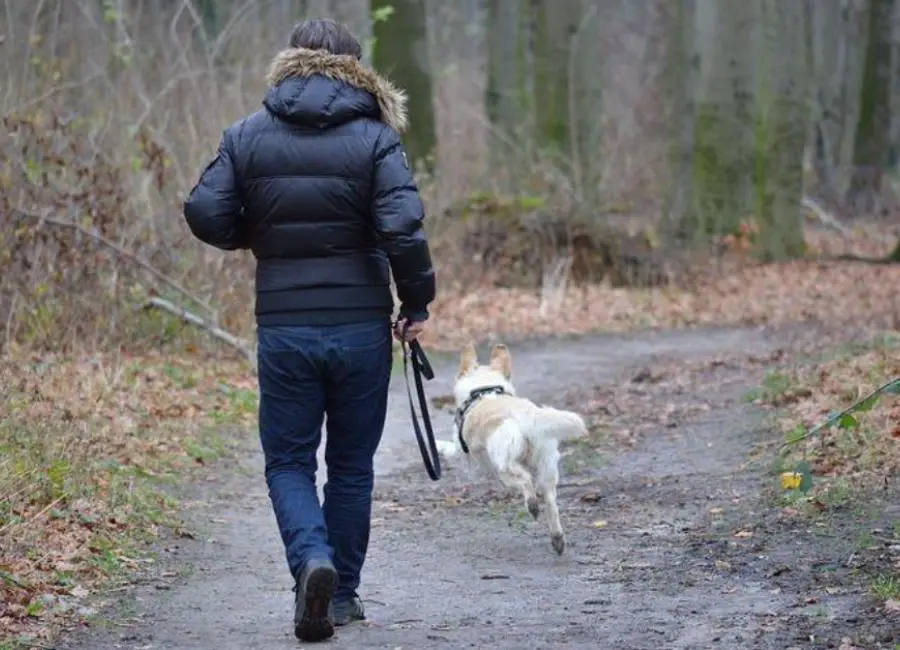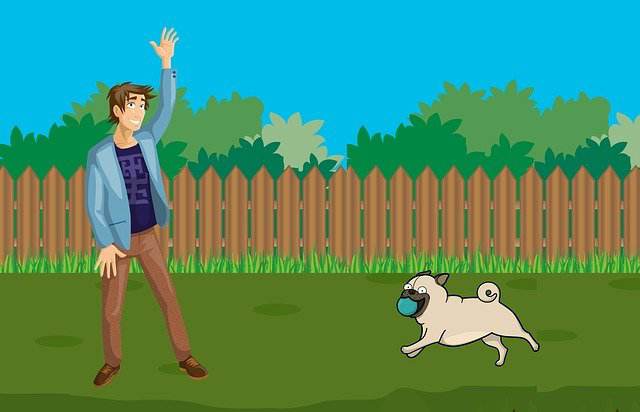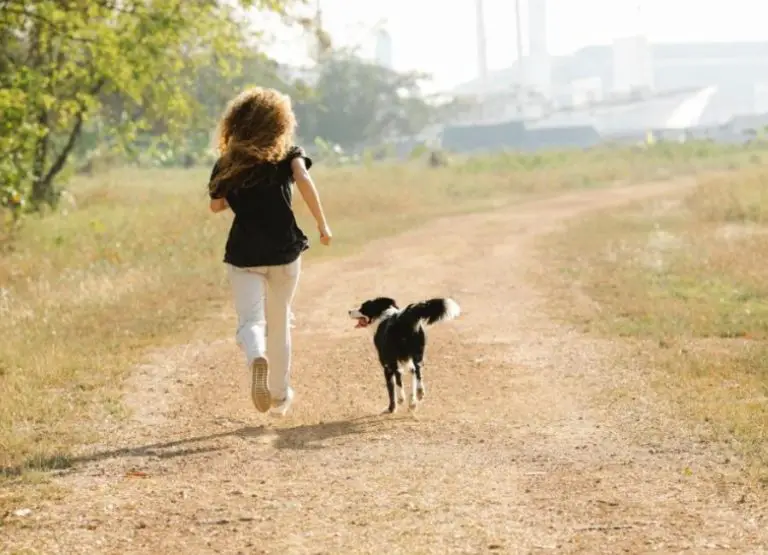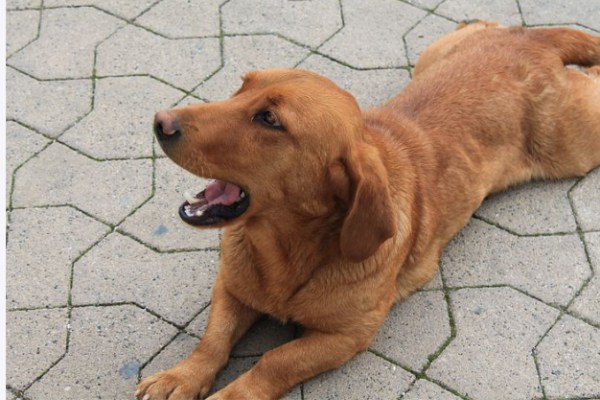11 Top Hints On How To Train a Dog Not To Run Away

Training a dog not to run away is sometimes difficult especially if it’s a hound breed so, let’s discuss how to train a dog not to run away!
There are many reasons why dogs run away from their owners which we will also go through.
Either off leash or from your home dogs can run away due to poor training, mating, or hunting instincts.
Whatever method your dog uses to escape, it’s not a laughing issue since he might be hurt, killed, or seized by animal control and taken to a shelter.
Let’s get down to business…
How To Train a Dog Not To Run Away
It will be difficult to teach your dog not to escape at every opportunity.
Giving your dog a stronger incentive to stay at home rather than run away is among the most effective methods to do so.
Raising your dog not to run away can enable you to keep him in the house, at the park, or on walks.
But, most crucially, it has the potential to save his life from dangers outside.
Here are some common ways or tips to help you train your dog not to run away:
1. Start proper obedience training
Proper and early obedience training sessions are one of the basics in training a dog not to run away.
Because of their outstanding scenting talents, most dogs are so preoccupied that you just need to do a very simple job with them.
For instructions and orders, develop a strong relationship and fundamental obedience commands such as “sit,” “stay,” “down,” and “come.”
It’s critical to start teaching your dog directions and on- and off-leash behavior as soon as possible.
When your dog’s primary goal is to rush outdoors, you may encourage him to stop, sit, and relax with good obedience training.
Ensure you begin obedience training as soon as possible, and remember to praise and treat your dog when he or she listens to and obeys an order.
Here are some basic obedience training commands:
- Go to place
- Drop it
- Leave it
- Stay
- Heel
- Look
- Sit
- Down
- Get it
- Go
- Come
- Roll
- Stop, etc.
Initial socialization is the most effective approach to teaching your dog not to run away from home.
The purpose of socialization is to train your dog to be a well-behaved and well-socialized member of society.
That involves being at ease in the presence of humans and other canines.
You must first understand your dog before figuring out how to make her feel at ease and secure in this situation.
When approaching your dog, look him or her in the eyes and speak to him or her with confidence, friendliness, and comfort.
Make sure you’re not in the vicinity of the food or water bowl.
Sit down so she can see you and see how calm you are and how patient you are.
Socialize your dog with all the things that can get him fired up and chased down.
Here are some tips on socializing your dog:
- Visit other dog owners.
- Take your dog for an evening walk.
- Take your dog to dog parks.
- Go for a morning walk with your dog down your street.
- Attend puppy classes.
- Take your dog to dog shows.
- Visit your family members and friends with your dog.
- Invite other dog owners.
- Provide a window view of the outside world for your dog to sit and watch.
- Take your dog to the beach on a leash.
3. Add value when your dog stays close
Your dog won’t try to run away from you if he knows he stands to gain from staying close to you, this is because dogs love gaining and not losing.
Your dog must learn that staying near to you is extremely beneficial, whether through praise, exercise, puzzle games, or rewards.
It is in your dog’s instinct to explore and wander, and their inquisitive nose might lead to danger if they can’t stay close to you.
You can let your dog run within your sight if it keeps near and can be trusted to heed recall orders through proper training and rewards.
Always give your dog the notion that staying with you is better than going outdoors or chasing after things outside.
Here is how to train your dog to stay close:
- Reward grooming sessions.
- Reward cuddling sessions.
- Initiate belly rubbing sessions.
- Try treasure hunting sessions.
- Play food or treats puzzle games.
- Praising command sessions.
- Teach your dog to do tricks.
- Play hide and seek games with rewards, etc.
4. Train your dog with clickers and whistles
Dog Clickers assist to shorten the period between when your dog performs a command and when it is provided.
If your dog has been clicker-trained, clickers offer the benefit of being linked with obtaining goodies versus whistles.
Using clickers and whistles to train your dog can assist keep him in control and teach him what to do at a given time.
If your dog has been properly taught, he will always respond when he hears a whistle or clicker.
If you don’t want your dog to roam too far away from you, clickers are a great option.
Whistles and clickers if used properly can help shape your dog not to run away.
5. Dog proof your home
The majority of dogs can only run away from home if you give them the opportunity to do so.
Fencing your home with a wire or wooden fence is one of the finest methods to dog-proof it.
When you place your dog in a fenced-in environment, make sure you offer all of the required tools to keep them happy.
You can always educate your dog to be content when he or she is confined within the fence.
6. Teach your dog to answer when called
Select a high-quality treat that your dog will only receive when you are doing the name answering training.
Your dog will be just as thrilled about goodies if you cut them up into tiny pieces during the training.
“Come,” for example, is a simple verbal order that you should practice with your dog over and over again.
You can also say “Jack, come,” or “Come Jack” remember that jack is your dog’s name.
Say come command instruction loudly and clearly once and make sure your dog hears you.
To check whether he/she reacts, wait. If he/she does not comply, repeat the instruction in a similar tone.
Distracting factors in the training environment, such as other people or the television, should be avoided.
Make sure that there are no escape routes for your dog during the name-answering training sessions.
This will limit where he or she can go if they become confused.
You can practice this outside and make sure to reward your dog with high-quality treats.
7. Teach your dog the treasure hunting game
Dogs do get bored when left alone, and they may wish to run away to get some activities.
You can get your dog to stay busy at home by teaching him the treasure hunting game.
Simply putting goodies about your house is one of the most common and simple ways to encourage your dog to stay at home and not try to flee.
To avoid health issues, do not leave treats in areas where they will be contaminated, keep your home clean, and do not provide too many goodies.
If you have some extra cash, invest in an automated goodies dispenser that will deliver treats at a low rate over a certain time period.
8. Train your dog to walk off leash
Only a calm and well-behaved dog will be able to stay off the leash without attempting to flee.
You may always begin training your dog indoors, both with and without a leash, to observe how he reacts.
Start with a loose leash walk, making sure your dog understands why you want her off the leash, and rewarding her with high-quality scent goodies at all times.
Before you let your dog off the leash, make sure you have a solid emergency recall strategy in place in case he decides to surprise you.
Reward if your dog start walking off the leash as this will help shape your dog not to run away.
Slowly introduce more distractions, and make sure you practice training commands with your dog off-leash in a secure location, such as your backyard.
You’ll need to practice “looking” off the leash and continue to praise natural check-ins as needed.
When you’re sure your dog is ready, consider letting him off the leash in the safest possible place for brief periods of time to watch how he reacts.
9. Avoid boredom and provide Entertainment & treats
Bored dogs get hostile over time and seek methods to have fun outside; as a result, never leave your dog alone.
If you’re busy with other activities, be sure to check in on you every now and again.
If you leave your dog alone for an extended amount of time, separation anxiety will develop.
Providing amusement for your beagle will help keep him inside all day and won’t let them run away.
Teach your dog to sit and watch TV shows and dog animation movies, and collect as many as possible.
This training is best done when your dog is still a puppy.
Always make time to sit and watch TV shows with your dog to help minimize your dog’s desire to go outdoors.
Always reward your dog with goodies if he or she watches TV with you or sits with you while you watch your favorite show.
10. Teach your dog to stay while you walk away
During this training, resist the urge to go too near to your dog since he could believe it’s a game.
You may now walk away from your dog after giving him/her a reward and praising him/her.
He or she will almost certainly follow you, particularly after you just complimented him.
Continue walking until he or she loses interest or becomes distracted and stops following you.
This should be done inside or in a confined environment, and your dog should not be allowed to run away.
You can start another activity on your own to divert your dog if he takes too long to leave you alone.
When the dog notices that you’re distracted, he or she will most likely become bored.
The main purpose of this training is to teach your dog that it is ok to stay without you and to come when needed.
11. Always reward your dog for coming back to you
Ensure your dog understands that returning is a good thing and that he should always come back when you call.
Praise him and give him a reward when he returns.
This incentive will educate him that returning back may be just as satisfying as fleeing.
Never reprimand a dog for returning to you after a lengthy absence.
This educates the dog that if he returns, he will be punished.
If you’re in the park, for example, call him back for a few moments before allowing him to continue playing.
If you contact him immediately before going home every time, he’ll learn that returning home implies playing is done.
Why do dogs run away from home
Here are some of the most common reasons your dog would want to run away from home:
1. Hunting or herding instincts
Because most dogs were carefully selected to herd or hunt, one of the main reasons your dog always wants to flee is that they were bred to run away.
Most dogs like being part of a pack, and these hunting instincts may cause your dog to flee from home.
Lack of socializing from the puppy stage forward, which is crucial later on is one of the reasons dogs try to run away by chasing things.
A socialized dog will always be calm and not run after other dogs or bark unnecessarily.
3. Dog found a better food source
If you live in an area where there are lots of dog lovers or dogs, your dog may want to have a short trip.
Most dogs follow odors a lot and might escape home if left alone since they enjoy eating a lot, which can cause them to flee.
If you allow your next-door neighbor to feed your dog more than you, you will most likely lose your dog, because they have a better food source.
4. Neglect or abuse by owners
Abusing your dog includes a variety of actions that you should be performing but aren’t, such as:
- Always shouting at your dog unnecessarily.
- Beating your dog for what so ever reasons.
- No playing time with your dog.
- No medical attention for your dog.
- Feeding stale food to your dog.
- Lack of attention for your dog.
- Rubbing your dog’s nose against its poop.
- Feeding your dog with table scraps or a poor diet.
5. Mating instinct
Mating instinct causes a dog to try to run to find a mating partner.
Because puppies don’t stay puppies for long, both male and female dogs have a strong desire to reproduce following sexual maturation at around 6 months.
And if you’re not cautious, you can end up with a litter of pups on your hands.
This intense desire is a typical motivation for dogs to flee.
6. Lack of mental stimulation or activities
Lack of exercise, boredom, or mental stimulation is all major causes of dogs fleeing.
They begin by attempting to capture that squirrel over there. Alternatively, walk down the street and make friends with the youngsters in the neighborhood.
Dogs are inherently inquisitive creatures who require daily stimulation and action.
If you don’t exercise or occupy your dog enough, he or she may become bored and try to amuse themselves by escaping and fleeing.
7. Stress or distractions
Too much stress can force a dog to want to run away from its home.
Another cause for a dog to flee is when they are in an unfamiliar area.
The possibility of your dog running away increases, especially during holidays.
New territory, odors, and diversions can easily lead to your dog exploring the area and becoming disoriented.
The potential risk of dogs running away
Here are some of the most common potential risks of your dog running away:
- The dog may run into a moving truck and get killed.
- Dogs may be killed by predators outside.
- The dog may get into fights with other dogs.
- Your dog may be taken away by the animal control team.
- The dog may end up in a shelter home.
- You may be depressed by the loss of your dog.
- The dog may be caught in humane traps.
- Your dog may lose sight of home and never return.
- The dog may be killed by dog-hating people.
- The dog may be infested with parasites or worms.



![Food Aggression in Dogs [Causes, Signs & Fix] Food Aggression in Dogs](https://petcreeks.com/wp-content/uploads/2023/10/pexels-vlada-karpovich-6801934.jpg)


